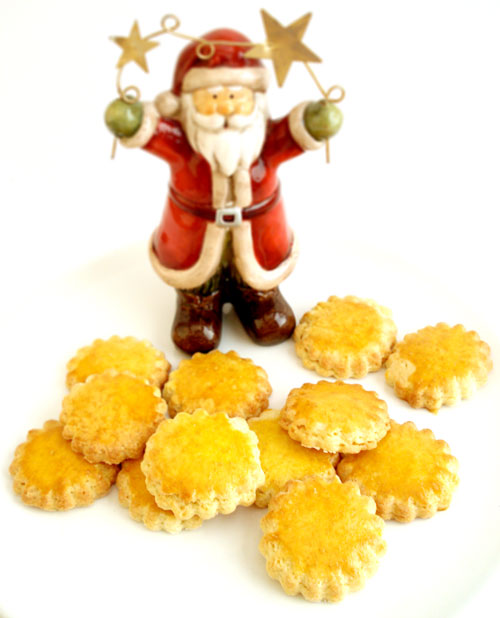
[From the archives. I'm not making a lot of cookies these days, but when I do these are still big favorites. They are quite plain but buttery-good, rather like shortbread but a little less rich. They are great Christmas cookies. Originally published December 2008.]
When it comes to cookies, I like them rather plain and not overly sweet. This traditional cookie from the Bretagne (Brittany) in France is so plain and simple, that the ingredients really shine. It is made of flour, sugar, egg, and the famously delicious salted butter (beurre demi-sel) of the region. Somewhat related to shortbread or sablé cookies but not as rich, for me they are almost the perfect cookie, and very more-ish.
The salted butter is the key to this cookie's distinctive nutty, buttery sweet-salty flavor. The best salted butter from the Bretagne and other regions along the Atlantic in France are creamy-fresh and rich, with little glistening crystals of salt still visible. If you can get a hold of really good salted butter, you can use traditional recipes and the cookies will turn out the way they should. If not, some adjustments need to be made. So, I would recommend following the variation of the recipe that meets your butter quality.
(You might see something called galettes bretonnes au sarrasin. These refer to a thin crêpe or pancake made out of buckwheat (sarrasin) flour, usually served with a savory filling. I love those too, but these article is about the cookie galettes bretonnes.)
Filed under:
baking cookies french christmas holidays bretagne
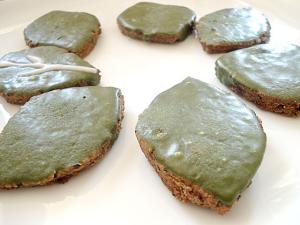
[From the archives. These sesame cookies with matcha icing look and taste quite dramatic. In leaf shapes they are rather spring-like, but try simple rounds or squares for year-round appeal. Originally published in April 2007.]
Flavor wise black sesame seeds aren't that different, if at all, from white or brown sesame seeds. But there is something about their dramatic black-to-grey color that is quite exciting. At the moment I'm quite enamored with black sesame seeds, and have been using them instead of the regular brown ones in everything from sauces to salads.
These leaf shaped cookies contain toasted and ground black sesame seeds, dark brown muscovado sugar, and whole wheat flour, and are decorated with matcha (powdered tea) royal icing. The sweetness is quite restrained, both in the cookie and in the icing. You are first hit by the tea-flavored, very slightly bitter icing, followed by the nutty darkness of the cookie. It's an intriguing combination. They are a wonderful accompaniment to tea, black or green, hot or iced. If the ultimate cookie to you means something very sweet and gooey you may not like these. They are quite adult cookies.
I had to shoot the pictures in a hurry, because they were disappearing faster than almost any other cookie I've made recently.
Since I don't have a leaf shaped cookie cutter, I just made a simple paper template and cut the leaves out with a knife. You can cut them out into any shape you'd like of course, though given the coloring leaves seem appropriate. Quite spring-like, in fact.
Filed under:
dessert japanese baking cookies favorites tea
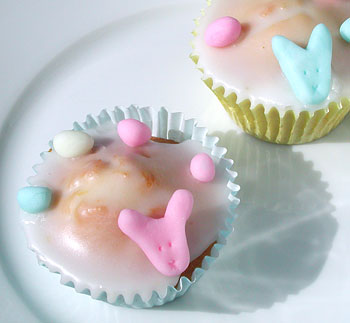
It seems that quite a few people have been trying out the kasutera/castella recipe recently, and running into problems. Castella is not an easy cake. So, since it's Easter, I thought I'd haul this out of the archives attic. These little 'rich tea cakes' are much easier to make, and while they have an entirely different texture they are really quite delicious. I hope you'll give them a try! The fondant is not too hard if you can get a hold of the glycerin, but alternatively you could use store bought Easter themed cake decorations. Originally published in March 2005, as part of the late lamented Is My Blog Burning food blog event.
Filed under:
food events party food imbb spring baking easter cupcakes bunny
From the archives. The very iffy photo shows that it is from the very early days of Just Hungry! I look back at this with nostalgia, because not only have my photography skills improved somewhat, it reflects a time in my life when I was into a far more complicated kind of cooking than I am now. I no longer bake things like this, but if you want a pretty spectacular chocolate dessert for Valentine's Day, and have the time and patience, I do highly recommend this rich yet feathery light little confection. I've edited it slightly to be more accurate (what the heck did I mean by 'small container of cream' anyhow). Originally published on February 13, 2004.
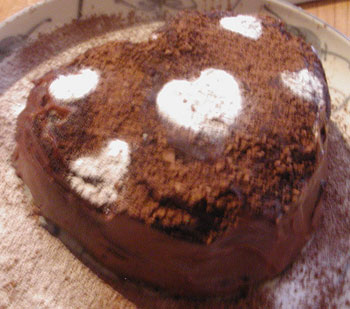
Filed under:
chocolate dessert baking cake
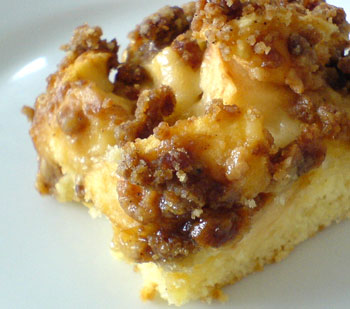
[From the archives. This very easy cake is especially nice at this time of year, when apples are in season. We don't actually eat this every day, but it's one of my go-to simple sweets to make. Originally published January 11, 2006.]
Filed under:
dessert fall baking quickbread cake favorites
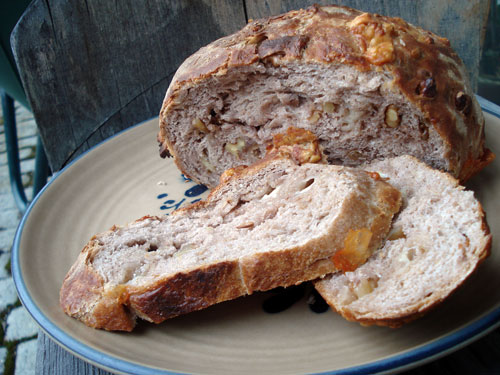
Notes on the Almost No-Knead Bread method, plus a recipe for bread with wine in the dough.
Filed under:
bread baking favorites
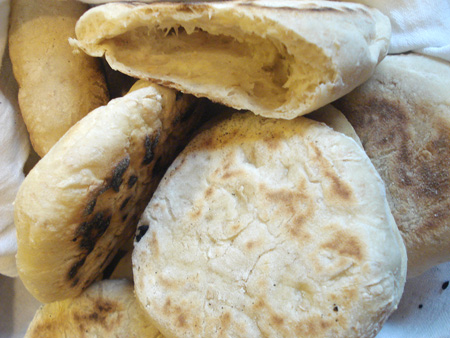
Even with more than 900 (and counting) posts and almost 200 recipes posted on Just Hungry, there are still lots of things that I make all the time, but haven't got around to writing about yet. A lot of those things take more time to write up than cook, almost. This whole wheat pita bread recipe is one of them. You do have to account for the obligatory rising time for the dough, but otherwise it's dead easy, and your kitchen working time in total is maybe 20 minutes, 30 tops. For fresh baked bread!
The key is that the pitas are not baked in the oven. No need for preheating baking stones or quarry tiles or all that stuff. They are baked, so to speak, in a plain old frying pan. You can make them any size you want as long as it fits in the bottom of the frying pan. I like to make small, palm-sized ones for easy snacking or bringing along for lunch.
This recipe also only requires 3 cups of flour in total. I sometimes get a bit frustrated by bread recipes that call for like 6 cups of flour, since we are a small household watching our collective waistlines and there's no way we can eat that much bread in a reasonable amount of time. Sure you can freeze the excess, but then you can quickly accumulate massive amounts of frozen bread if you bake often. So anyway, this makes 12 smallish pitas, which are gone quite quickly, especially with a resident Bread Fiend in house.
I referred to many other pita bread recipes, especially this excellent one on About.com, before arriving at this version. The cooking in the frying pan concept came from watching naan bread and Chinese flat breads puff when cooked on griddles. A griddle is not necessary though - and I think most people have at least one frying pan.
Filed under:
bread baking favorites
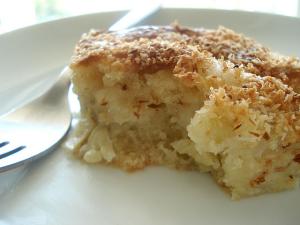
Some recipes come about from long experimentation and several tries to try to perfect them (like those darned bunnies, or my ongoing attempts to make natto at home). Others just seem to happen. We had a bunch of bananas that were rapidly turning very brown and spotty on the kitchen table. I froze some (nothing like frozen bananas as treats), and turned some into a cake.
It's nothing fancy at all - it's basically a pound-cake like base (but with a bit less sugar), with added cut-up bananas. The coconut part was added on a whim also. The cake doesn't rise much, probably because of the bananas, but it's moist, not too sweet, and very comforting. It's perfect with a cup of tea.
So far in my life I've not had the opportunity to go to Hawaii (unless you count a short layover en route from LA to Tokyo) but I sort of imagine that this cake would not be too out of place there.
Filed under:
baking cake quickcook
Some years ago, when silicon baking wares came out, I jumped on them with glee. No more scraping off baked on crud from the baking sheets! Muffins that popped right up with no greasing of the cups required! Easy washing up!
But these days I've definitely fallen out of love with silicon sheets and silicon muffin pans and the like.
About those muffin pans first: while muffins do brown on the outsides, they don't get as crispy-brown as I'd like. They also seem to rise a bit less than I'd like.
Also, they are totallly useless for popovers and Yorkshire puddings. You can't really heat them up, so you can't make them piping hot and pour in hot batter. The alternative method for making popovers 'pop' is to start them in a cold oven, but that doesn't work either. So I end up with flat, boring muffins of a sort, rather than high and airy pockets of trapped air and eggy, moist insides. Yes, I know I could just get separate pans for the popover and Yorkshire puddings, but I don't have that much storage space in my not-too-large kitchen, and I like to avoid 'single-use' type equipment as much as possible.
As for silicon baking sheets, used to line heavy baking sheets, they do okay on the browning front. But what I dislike about them is that, after a few uses they take on an unpleasantly 'greasy' feel to them. No amount of washing or soaking in soapy water seems to cure that. I don't know if I'm over-sensitive to this, but it drives me nuts. So I end up throwing them out over maybe 3 uses. This doesn't seem too economicalor environmentally friendly to me. (Do those things disintegrate at all in landfills?)
So, I'm back to good old metal baking tins and lining my baking sheets with kitchen parchment paper. My old metal muffin pans tend to stick a bit on the bottoms, so for delicate cupcakes and such I just use paper cupcake liners. (Which means of course I avoid those individual silicon cupcake cups.) Paper, at least, does disintegrate after a while.
How do you feel about those silicon baking products? Do you love them or hate them?
Filed under:
equipment baking ethics
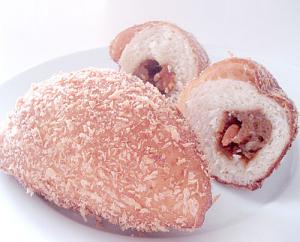
There's a whole category of breads in Japan called okazu pan. Okazu are the savory dishes that you eat with your bowl of rice at a typical meal, and okazu pan are little breads with savory fillings.
Since curry flavored anything is a hit in Japan, curry bread or kare- pan is one of the most popular okazu pan varieties. It's a bun made of slightly sweet dough, filled with a spoonful of curry, breaded and deep fried. I am not sure how curry bread originated, but I am guessing it was inspired by Russian piroshki (piroshiki is also a popular okazu pan, though in the Japanese version it often contains very non-Russian fillings like harusame, thin bean noodles). Curry bread is sold at bakeries and convenience stores throughout Japan.
Making curry bread is a bit tricky since it's deep-fried. It's easy to make an oily, soggy lump if you fry it too long or at too low a temperature, but if you don't fry it long enough the center part where the dough meets the filling may be raw. My solution for this is to fry it until it's puffed and crisped, then to finish it in the oven. The other trick is to roll out the dough as thinly as you can manage without making it so thin that the curry is going to burst through.
You also have to be careful about the consistency of the curry filling. It's most convenient to start out with some leftover curry, but it has to be reduced down to a very thick, paste-like consistency, otherwise it will run over the dough and make the dough hard to seal. If the dough is not sealed properly, the bun will burst in the oil, which ends up to be quite a mess (oil seeps in, filling seeps out).
All in all, I am not sure I would bother to make curry bread at all if I lived near a Japanese bakery, but I do on occasion get a craving for this very down to earth snack. Try it if you're up for a bit of a challenge. This recipe is adapted from one in an out-of-print Japanese bread book.
Filed under:
bread japanese snack baking curry
Pages